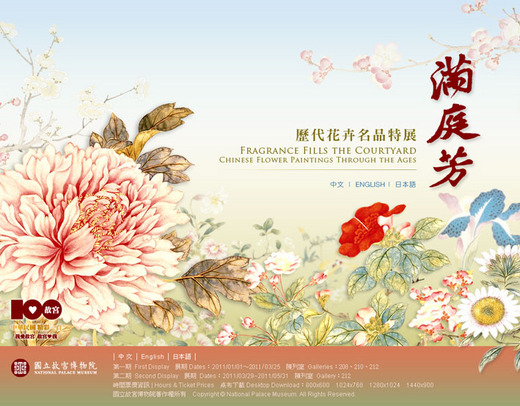

 字體:小 中 大
字體:小 中 大 |
|
|
|
| 2010/11/25 21:57:33瀏覽337|回應0|推薦2 | |
滿庭芳網頁設計初稿出爐了........ 花卉是美的使者,以萬狀千態,繽紛色彩,憑添自然界的燦爛與動人,受到古今中外多少文學藝術家的讚嘆,留下了千古絕唱。在中國最早的詩歌總集《詩經》中,便藉花卉來比擬美好的事物,如「桃之夭夭」,是以桃花嬌嫩的姣好容顏,祝賀女子新婚之喜;「顏如舜華」是以古名舜華今名木槿的多變色彩,描寫女子的美貌,顯示出約三千年前古人對花卉的觀察。 在中國繪畫史上,山水、花鳥、人物為三大主題,花卉是花鳥中主要題材之一,成為歷代畫家喜愛描繪的對象,他們不但直接描畫花卉的形色之美,也展現其神韻風采,更進一步賦予含意,託物寄情。一如明王象晉《群芳譜》所說:「試觀朝華之敷榮,弘秀之競爽,或偕群卉而並育,或以違時而見珍,雖艷質奇葩,未易綜攬,而榮枝開落,輒動欣戚,誰謂寄興賞心,無關情性也。」 故宮所藏以花卉為主體的作品,歷代均有佳作,特舉辦「滿庭芳-歷代花卉名品」特展,分為「一年好景」、「境由心造」、「丹青面目」和「祥瑞吉兆」四個單元展出。遴選四時花卉表現季節和時令,顯示畫家如何以巧思構景造境和運用雙鉤填彩、沒骨、白描和寫意等基本技法,讓單純的題材呈現多種面貌或時代性,並解析繪畫中的吉祥寓意,以便欣賞畫家展現的不同角度,賞析花卉繪畫特有的美感和多樣性。 展覽期間,適逢台北市舉辦「國際花卉博覽會」,恰可將生態與藝術之美,古今名花兩相映照,讓觀賞者享受並沈浸在一片花團錦簇的綺麗世界中。 一年好景 「一年好景君須記」、「莫待無花空折枝」等名言佳句,訴說的都是古人賞花、愛花與惜花的心境。四時花開,為季節妝點出不同雰圍,諸如春的柔美絢爛,夏的濃鬱繁華,秋的清寂沈靜,與冬的冷洌高潔,均各有代表花卉,依時序次第綻放,也衍生出「十二月花神」的美麗傳說。花卉不僅可以傳遞季節更迭的訊息,傳統民俗中的節令,諸如歲朝、端午,同樣可以藉花卉來表現。本單元除了遴選描寫單種花卉的作品來表現季節,也展出四時花卉合卷及合冊,以及與節令相關的作品,提供給觀眾全面性的欣賞角度,共感四時與年節的繽紛氣息。 境由心造 構圖和技法是繪畫創作的兩大元素,缺一不可。畫家固然可以依據眼中所見,如實描繪,更可在觀察景物之後,經過融會貫通,創造出心中理想的景致,與觀眾分享。甚至不止於寫景,還可以寫情,透過丹青妙手,傳遞春、夏、秋、冬的季節感,或者風、雨、霜、露等情境。畫史將花卉畫的基本構圖方式,歸納為「全景」、「小景」、「折枝」與「瓶插」等四大類,事實上,每一種方式都包含有多元的表現手法,或極繁、極簡,或顯、或隱,可謂幻化多端,耐人玩味。 丹青面目 花卉之美在於形與色的多變,而能展現其中細節的,正是繪畫的技法層面,誠所謂「丹青捻出面目來」。歷代畫家運用筆墨色彩描寫花卉,發展出「工筆」、「沒骨」、「白描」和「寫意」等四種基本技法,各時代俱有其特色,同樣的技法在不同時代,也會有不同面貌。一件作品可以採單一技法,或者綜合活用,甚至染配特別底色,形成宛如「鋪殿」式的效果。本單元在陳列上,除了介紹作品的時代與風格特質,並會藉助同一種花卉、不同技法的比對方式,來加深觀眾對於箇中異同的印象。 祥瑞吉兆 花卉雖然是值得欣賞的自然美景,但在人們心目中,早已逐漸由客觀的賞愛對象,轉化為可以寓意寄情的朋友。所以「落紅不是無情物」,非僅只花開花落隨時而已。在這種心情下,人們賦予了花卉吉祥的意義,借助「同音」和「諧音」等方式,讓好花對應良辰景,化身成許多吉祥語的象徵物。在歷代花卉畫中,有些作者確實精心設計吉祥涵義,不同於純粹描寫花卉情態,表達筆墨意趣的作品。本單元同時並列這兩類畫作,爰以說明花中蘊含的吉祥意義,也呈顯歷代花卉名品的多元特性。 Fragrance Fills the Courtyard: Chinese Flower Paintings Through the Ages Flowers are like emissaries of beauty, greeting viewers with their myriad forms and colors. Indeed, the splendor they bring to Nature moves the hearts of people everywhere. For this reason, artists and writers all over the world have been attracted to flowers down to the present day, leaving behind many equally beautiful masterpieces. In China’s earliest collection of poems and songs, The Book of Poetry, flowers often serve as metaphors for beauty. For example, “The peach tree is young and elegant” uses the beautiful imagery of delicate peach blossoms to express the joy of a young maiden who has newly wed. “With a countenance like the (ephemeral) hedge-tree flower” refers to the varied colors of a plant known in ancient times as the hedge-tree (nowadays called the Rose of Sharon, or Hibiscus syriacus) to describe the beauty of a girl. Such descriptions reveal the ancients’ level of observation regarding flowers some three millennia ago. Over the course of Chinese painting, the three main subjects have been landscapes, birds-and-flowers, and figures. Flowers, a major subcategory in the bird-and-flower genre, became the object of attention and depiction by painters throughout the ages. Artists not only directly portrayed the outer beauty of flowers, they also expressed the subtle spirit and demeanor of their subject. Painters went even further to imbue blossoms with deeper meaning, transforming them into objects for lodging feelings. As the Ming dynasty author Wang Xiangjin wrote in Record of All (Flowers) Fragrant, “I try to observe the morning flowers putting on their splendor, competing in all their great beauty and fragrance. Some keep company with others as they grow, while others go against time and show their preciousness. Despite their great floral beauty and exotic nature, such myriad manifestations are not easy to grasp. Their flourishing stems bloom and wither, also bringing joy and sorrow. Who says that such lodgings of joy and pleasantries of the heart are unrelated to the emotions and character?” Paintings on the subject of flowers in the collection of the National Palace Museum include many excellent examples down through the dynasties. The selection presented in this special exhibition has been divided into four sections: “Beautiful Scenes All Year Round,” “Formal Expressions of the Mind,” “Their Many Features in Painting,” and “Auspicious Signs and Lucky Omens.” Flowers blooming throughout the year have been chosen to express their relation to the seasons and certain festivals in China. These artworks also demonstrate how artists used their skill of compositional arrangement and such basic techniques as ink outlines filled with colors, “boneless” washes, fine ink lines, and freehand “sketching ideas” to transform apparently simple subjects into a wide variety of forms and manners in keeping with the times. The interpretation of auspicious metaphors in paintings also reveals how artists portrayed blossoms from yet another point of view, allowing viewers to further appreciate the unique beauty and diversity of flower painting. This exhibit coincides with the 2010 Taipei International Flora Exposition being held by Taipei City, providing visitors an opportunity to enjoy the wonders of actual flowers and those captured by Chinese painters of the past. Comparison of both types of flowers on display at these venues offers viewers a way to enjoy and immerse themselves in two different yet equally gorgeous worlds of floral bouquets. |
|
| ( 創作|文學賞析 ) |










